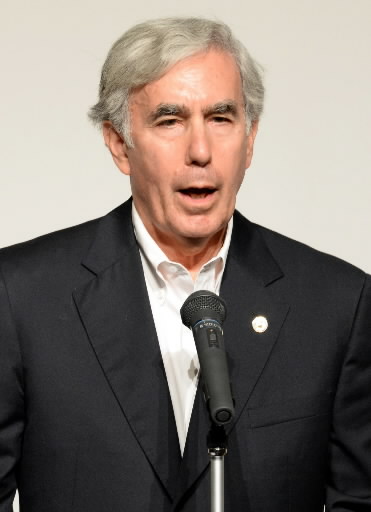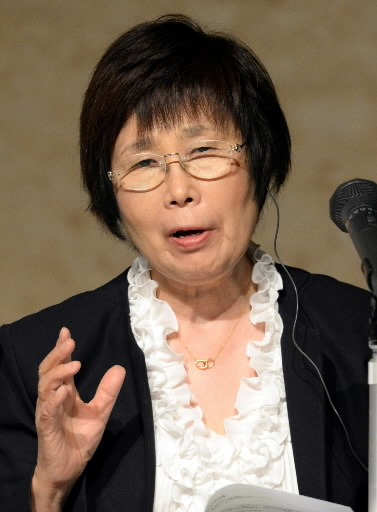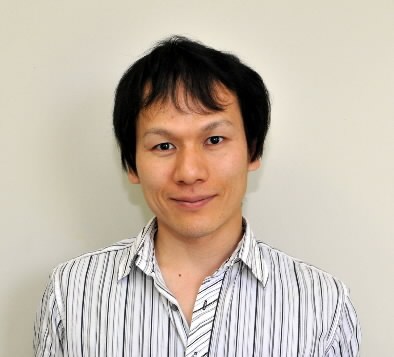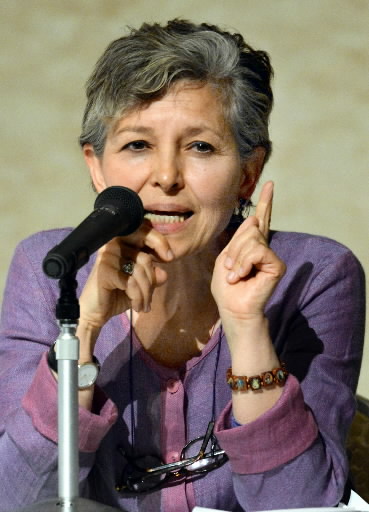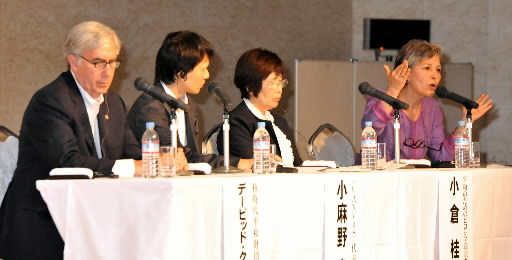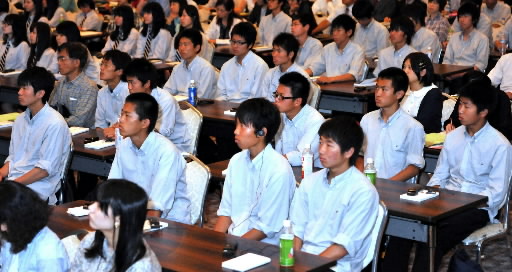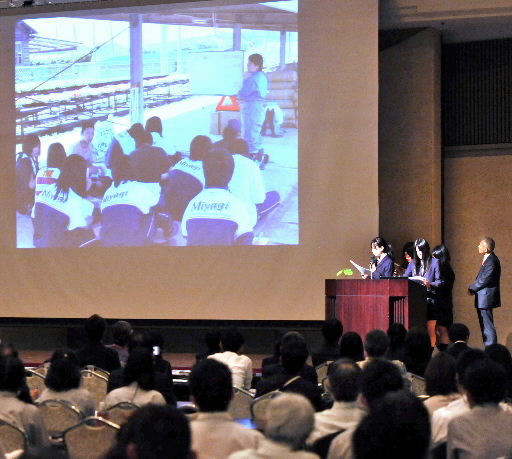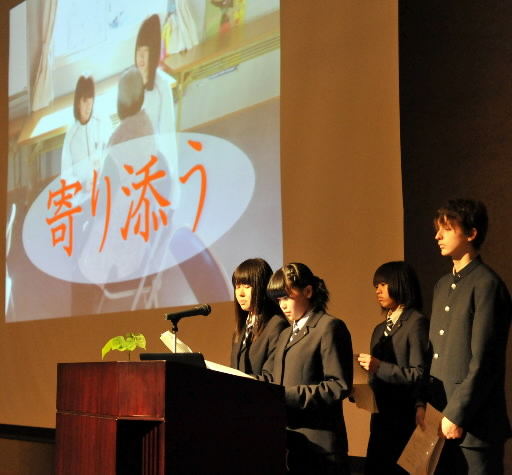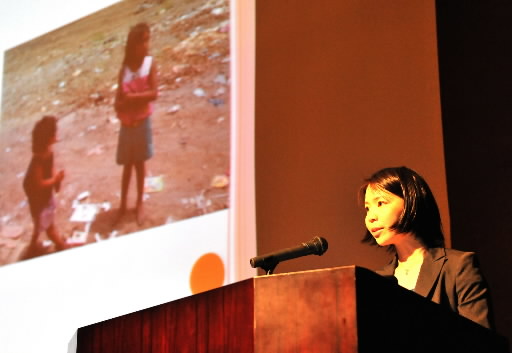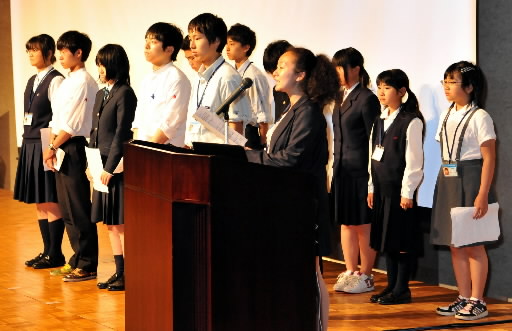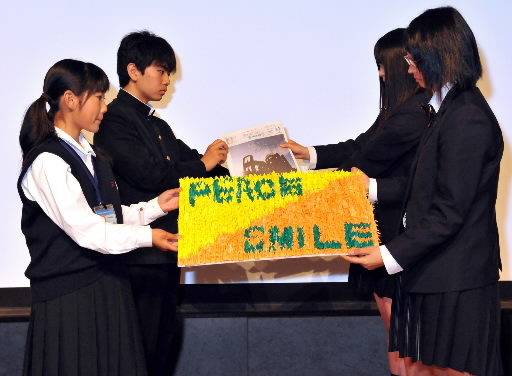Report on Symposium“Toward a Nuclear-free World: Spreading Hiroshima’s Message”
Jun. 3, 2013
by Rie Nii, Michiko Tanaka, Sakiko Masuda, Aya Kano, Shinichiro Origuchi and Kyoko Niiyama, Staff Writers
A symposium titled “Toward a Nuclear-free World: Spreading Hiroshima’s Message” was held on May 25 at the International Conference Center Hiroshima to mark the fifth anniversary of the establishment of the Hiroshima Peace Media Center at the Chugoku Shimbun. Participants explored the path to the abolition of nuclear weapons through the keynote speech by an expert on nuclear issues and a panel discussion featuring an atomic bomb survivor who mastered English in order to tell of her experiences, the leader of a group of young people that conducts international exchanges with people in Kazakhstan, where many people have been exposed to radiation, and a former United Nations official with broad international experience. The need to promote collaboration involving young people at the grass roots level was pointed out, and the discussion developed with the expression of various opinions, such as the need for Hiroshima and others to convey to the international community how inhumane nuclear weapons are. About 400 people attended the symposium, which was sponsored by the Hiroshima Peace Creation Fund, the Hiroshima International Cultural Foundation and the Chugoku Shimbun.
Keynote speech “Hiroshima:City of Hope”
By David Krieger, president of the U.S.-based Nuclear Age Peace Foundation
Panelists
Mr. Krieger
Keiko Ogura, A-bomb survivor, representative of Hiroshima Interpreters for Peace
Takayuki Koasano, leader of Creative Active Network in Various Styles, a Hiroshima-based international exchange group
Nassrine Azimi, senior advisor to the United Nations Institute for Training and Research
Moderator
Akira Tashiro, executive director of the Hiroshima Peace Media Center
[Profile]
David Krieger
Born in Los Angeles in 1942. Received a Ph.D. in political science from the University of Hawaii in 1968. After serving as an associate professor at San Francisco State University, founded the U.S.-based Nuclear Age Peace Foundation, a non-governmental organization, in 1982 and became its president. Editor and author of numerous works such as “Zero: The Case for Nuclear Weapons Abolition.” Also involved in peace education for high school students and other young people in the U.S.
Keiko Ogura
Born in Hiroshima in 1937. Was in Ushita-cho (now part of Higashi Ward), 2.4 km from the hypocenter, at the time of the atomic bombing. Has interpreted for and coordinated visits to Hiroshima by foreign peace activists, artists and others for more than 30 years. Established Hiroshima Interpreters for Peace (HIP) in 1984 and serves as its representative.
Takayuki Koasano
Born in Hiroshima in 1979. In 2001, while a senior at Hiroshima City University, participated in a tour of Kazakhstan in support of people who had been exposed to radiation and learned about the situation there. Founded Creative Active Network in Various Styles (CANVaS) in 2003 to promote ongoing exchanges with young people in Kazakhstan and has visited that country six times.
Nassrine Azimi
Born in Iran in 1959. Moved to Switzerland at the age of 17. Named program coordinator for the headquarters of the United Nations Institute for Training and Research (UNITAR) in 1991. Became the first director of the agency’s new Hiroshima office in 2003. Since stepping down in 2009, has been active in peace-related activities in Hiroshima. Co-founded “Green Legacy Hiroshima” in 2011. Also submits opinion pieces to U.S. newspapers.
Tashiro: Hiroshima has been saying that the theory of nuclear deterrence is wrong yet Japan is under the protection of the nuclear umbrella, so the theory of nuclear deterrence can’t be dispelled. How can we overcome this and move toward the abolition of nuclear weapons?
Krieger: Can security be assured if you have nuclear weapons? I don’t think so. The theory of nuclear deterrence is a hypothesis that states that a country can assure its security by posing a threat to its enemies. But not all leaders of nations or terrorists are necessarily rational. They are violating ethics based on a mistaken idea.
Koasano: We need to emphasize how inhumane nuclear weapons are through an international mechanism. How nuclear nations can take initiative is also important. It is citizens who have to get those ideas and questions out. At the state level it gets caught up in the political framework and tied to national interests. I would like to pursue international cooperation at the grass-roots level.
Ogura: Some people feel reassured because their country has nuclear weapons. And most of the younger generation feels that the nuclear issue is something that the leaders of some other country will address. People who are uninterested in nuclear issues change their way of thinking the moment they hear the stories of atomic bomb survivors. This means learning not only how many died but also how those who survived suffered. Then they come to feel strongly that nuclear weapons are an absolute evil. It’s not a matter of logic.
Azimi: The costs of nuclear deterrence are tremendous. In some cases more money is spent on nuclear weapons than on social security or education. How many important projects are given up, in order to devote money to the fiction of nuclear security?
Krieger: The alternative to nuclear deterrence is the abolition of nuclear weapons. In order to bring that about, irreversible steps must be taken and a treaty with transparency must be drawn up. Japan could lead this effort. The U.S., which created nuclear weapons, used them first and has expanded their production, also has a responsibility to exercise leadership.
Tashiro: But at the second meeting of the Preparatory Committee for the 2015 review conference of the Nuclear Non-proliferation Treaty in Geneva, 80 countries approved a joint declaration on the effects on humanity of nuclear weapons, but Japan did not support it.
Ogura: There is always a gap between the attitudes of the government and the people. It’s the same with policy on nuclear power. It’s all of you who will change that. Those who have heard the voices of A-bomb survivors even once have a responsibility.
Krieger: I’d like you to broaden leadership by young people beyond Hiroshima. This is something that is needed not “someday” but now.
Tashiro: What would you like to see Hiroshima’s news media to do in order to enhance Hiroshima’s message? Do you have any recommendations for citizens’ activities?
Krieger: Conveying to the U.S. Hiroshima’s way of looking at things would be very useful. How about if Hiroshima’s news media entered into an agreement with foreign news media? If articles were posted on the websites of foreign news media, Hiroshima’s viewpoint could be disseminated more widely.
Koasano: That’s a good idea. Holding a symposium in cooperation with foreign news media would be good too. As for citizens’ activities, I think continuity is essential. I started by preparing materials on Kazakhstan and showing them to one or two close friends. As I continued my activities, more people took an interest in what I was doing, and the scope of my activities broadened. The world is becoming more accessible with the development of the Internet. Now we are also working to get our message out that way.
Ogura: The Chugoku Shimbun used to run the Akiba Project under which journalists from local newspapers in the U.S. and others were invited to Hiroshima. How about inviting young people from nuclear nations and other countries to Hiroshima? If the interviews they conducted and the articles they wrote could be published in their homelands, they could be read by other young people. These articles should have a major impact.
I’d also like to see articles from the Chugoku Shimbun translated into various languages, and I’d like the effort to get Hiroshima’s message out to continue. I’m sure there are financial considerations, but how about translating articles into Korean and other languages as well as English?
Azimi: What is Hiroshima’s unique strength? It is the spirit of “forgive but don’t forget.” I’d like to give the same message to the news media and the people of Hiroshima. We tend to get caught up with form and forget about substance. We have to keep asking ourselves whether the current approach is really the right one. Doing so will generate more sensible ideas.
I’d like young people to take an interest in all sorts of things. Everything is connected: Hiroshima, Fukushima, Japan’s postwar history, the budget of the U.S. Defense Department, nuclear energy… You can’t make decisions about things by looking at only one dimension. So, young people need to read widely: poetry, history, politics, science. I’d like them to try to make connections between things and think about them.
Tashiro: How do you feel about the peaceful use of the atom? There was a time when the news media regarded nuclear power as “the energy of the future.”
Koasano: Although some of the numerous nuclear tests the former Soviet Union conducted during the Cold War with the U.S. were for peaceful purposes, the goal of most of them was to strengthen the Soviet Union’s military capabilities. Residents of those areas suffered serious harm from exposure to the radiation that was released over a long time. In Kazakhstan the air and water were contaminated. The river that runs through Semey (formerly Semipalatinsk), which is near the test site, goes through Russia and flows into the Arctic Ocean. Contaminated water got into the river and before anyone realized it cross-border radiation contamination had occurred. It’s like the accident at the Fukushima No. 1 (Daiichi) nuclear power plant, which caused people to feel anxious about radiation contamination.
Azimi: Unlike Kazakhstan, Japan has a lot of earthquakes. It’s a small country, so where can people evacuate to? Nuclear energy poses a risk, and though it may be very small, it makes it unacceptable to have nuclear power plants. Nevertheless Japan is planning to export its nuclear power technology. Is this morally acceptable? It takes a long time to dismantle a nuclear power plant. We have to discuss more transparently the costs involved in dismantling plants or in radiation contamination.
Krieger: It’s called a peaceful use, but if you extract the nuclear material from the spent fuel generated by a nuclear power plant, it can be diverted to nuclear weapons. This is a source of concern in terms of nuclear proliferation, and it means we can’t bring about a world without nuclear weapons. Although there is no solution to the problem of the disposal of radioactive waste, which poses a danger to humans, the effects will linger for thousands of years. There is also the possibility that nuclear power plants could be destroyed in a war or by terrorism.
Azimi: Japan is behind when it comes to the field of renewable energy. It has been passed up by the U.S. and China. It would be meaningful for Japan to move forward in terms of economic incentives as well. If it has the technology, Japan should be doing its utmost.
Ogura: I’ve had foreigners say to me in frustration, “Why didn’t Hiroshima consider nuclear power?” It’s true that a lot of atomic bomb survivors didn’t pay any attention to the issue for a long time and just felt it was the government’s problem. I’d like young people to broaden a new network and debate this issue thoroughly.
◇
(Diana Roose, an American journalist and peace activist, was scheduled to participate in the panel discussion via Internet video, but she was forced to cancel on account of illness.)
[Reports presented by young people]
At the symposium four teams of young people from Hiroshima and Miyagi presented reports on their efforts in pursuit of a peaceful world. Students from Itsukaichi High School in Hiroshima who visited Miyagi Prefecture, which was hit by the Great East Japan Earthquake, talked about their activities there. Students from Miyagi Agricultural High School in Natori, which conducts exchanges with Itsukaichi High School, described the damage caused by the tsunami and the effects of the accident at the Fukushima No. 1 (Daiichi) nuclear power plant on agricultural and livestock products. A former member of the Japan Overseas Cooperation Volunteers of the Japan International Cooperation Agency (JICA) recalled an exhibition on the atomic bombing that she held in the country where she was posted. Junior writers from the Chugoku Shimbun reported on the Peace Smile Festival for junior and senior high school students that they planned and put on in March.
Tomomi Hasebe, 17, student body president, three other third-year students from Miyagi Agricultural High School, and Kikuo Shiraishi, 59, the school principal, described the devastating impact of the tsunami on their school building and the harmful rumors that have been spread about agricultural products in the aftermath of the accident at the nuclear power plant.
The students played a video showing many cars that were on the school grounds being pushed along by the tsunami. The school was forced to relocate, and the students now study at temporary facilities in Natori, where their school was located. The students also talked about their efforts toward reconstruction including caring for cattle that survived the tsunami.
With regard to the accident at the nuclear power plant, Mr. Shiraishi said, “We are still feeling the effects in neighboring Miyagi Prefecture too.” He also shed light on the present situation, including the fact that people avoid fruits, vegetables and rice grown in Miyagi because of rumors of radiation contamination. “I feel sad that some of Japan’s lush green nature has been lost,” he said.
Mr. Shiraishi and the students declared their resolve to “move forward little by little, like the people of Hiroshima, who rebuilt the city from the ruins and who have worked for world peace.” Earlier that day, during a visit to the Peace Memorial Museum, they were given seedlings grown from a Chinese parasol tree that survived the A-bombing. Holding the seedlings, the principal and the students promised to take them back to their school and plant them.
Four second- and third-year students from Itsukaichi High School talked about the importance of continuing to lend support to victims of the earthquake. In November of last year the students visited Miyagi Prefecture. They reported on how they helped with the restoration of farmland and their gift of audio-visual equipment to Miyagi Agricultural High School.
The students visited temporary housing to hear the stories of elderly people who had lost friends and family in the disaster. They thought about ways to gain the trust of the victims in order to offer more support and came up with ideas such as listening to them patiently and greeting them cheerfully. The students said they were moved to tears by what the victims told them. One student said, “I took having friends and family for granted, but it’s really something to be very happy about.” Another said, “We must make the most of every day.”
Manami Daigo, 16, a second-year student, recalled her late grandfather, who was an atomic bomb survivor. At the time of the A-bombing he was a second-year student at Hiroshima Second Middle School (now Hiroshima Kanon High School). The second-year students were scheduled to dismantle buildings near the site of the bombing, but it was suddenly decided that the first-year students would go instead. All of them were killed. Ms. Daigo’s grandfather felt guilty about having survived and never spoke of his A-bombing experience. She said the disaster victims who had lost loved ones and those who suffered anxiety and hardship as a result of the nuclear accident reminded her of her grandfather.
Adam Eldridge, 17, a third-year student at the school summed up by saying, “Our mission is to continue to offer support to the victims of the disaster.”
Norimi Osaka talked about her experience putting on the first exhibition on the atomic bombing ever held in Nicaragua in Central America in 2004 while she was a member of the Japan Overseas Cooperation Volunteers (JOCV). Titled “Hiroshima Seen through an A-bombing Exhibition Overseas,” her talk focused on the significance of conveying the story of the destruction of Hiroshima and its recovery to people overseas.
Ms. Osaka went to Nicaragua in 2003 and spent two years there. The country was impoverished in the aftermath of the civil war, and the people had no hope. Although they knew the name “Hiroshima,” many people did not know about its history of recovery.
Ms. Osaka and three other volunteers from Hiroshima held an exhibition on the A-bombing in three locations, including the capital of Managua, in an effort to give people hope for recovery and to convey the importance of peace.
When visitors asked why she didn’t hate the United States, she didn’t know how to answer and repeatedly asked herself that question. She said she reached the conclusion that it was because the atomic bomb survivors had related their experiences to her and the next generation with the hope that no one else would experience what they had.
As a result of the efforts of Ms. Osaka and the other volunteers from Hiroshima, the JOCV held A-bombing exhibitions in countries around the world, including Cambodia and Ethiopia. So far exhibitions have been held more than 100 times in 56 countries.
“The value of Hiroshima lies in the belief that there must not be a cycle of retribution but rather a spirit of reconciliation,” Ms. Osaka said. “I would like to spread this message around the world so that it will lead to nuclear abolition.”
Twelve junior writers reported on the Peace Smile Festival for junior and senior high school students, which was held at the Chugoku Shimbun building in Hiroshima on March 30. They stressed that if people take action toward world peace starting with everyday activities their desire for peace will lead to connections beyond borders.
Miyu Sakata, 17, a third-year high school student who served as chair of the committee, explained what inspired the junior writers to hold the festival. “We wanted to let more people know about our activities and create connections between junior and senior high school students,” she said.
During the musical portion of the festival, local junior and senior high school students performed songs written on the theme of the atomic bombing and sang prayers for peace to the accompaniment of a piano that survived the A-bombing. The chorus from Aoi High School in the city of Aizuwakamatsu in Fukushima Prefecture was also invited to perform. Fukushima was the site of the worst nuclear accident in Japan’s history following the Great East Japan Earthquake. The choir’s performance conveyed their hope for reconstruction.
Workshops were held on seven topics, including the familiar subject of bullying as well as international cooperation. One student said, “Peace does not only mean no war or nuclear weapons. We can also create it starting with the world around us.” Another said, “In order to achieve peace, it’s important to tell people about events, even unhappy ones.”
At the end of their report the students read a declaration titled “Our Peace Smile,” in which they called for implementing seven objectives such as being broad-minded and trusting others.
◇
The junior writers gave the students from Miyagi Agricultural High School a special signboard they had made with visitors to the Hiroshima Flower Festival and a copy of a special edition of their newspaper for high school students titled “Let’s Learn about Hiroshima.”
The signboard, which measured 45 by 60 cm, featured the words “PEACE” and “SMILE” formed by about 1,000 folded paper cranes of yellow, orange and green that covered the board. The students had written messages of support for reconstruction of the disaster area on each of the paper cranes. “Let’s Learn about Hiroshima” is a 24-page tabloid paper that features articles on interviews the junior writers did with A-bomb survivors in which they talked about their experiences.
The junior writers presented their gifts to the students from Miyagi on the dais after they had finished their report.
(Originally published on May 27, 2013)
A symposium titled “Toward a Nuclear-free World: Spreading Hiroshima’s Message” was held on May 25 at the International Conference Center Hiroshima to mark the fifth anniversary of the establishment of the Hiroshima Peace Media Center at the Chugoku Shimbun. Participants explored the path to the abolition of nuclear weapons through the keynote speech by an expert on nuclear issues and a panel discussion featuring an atomic bomb survivor who mastered English in order to tell of her experiences, the leader of a group of young people that conducts international exchanges with people in Kazakhstan, where many people have been exposed to radiation, and a former United Nations official with broad international experience. The need to promote collaboration involving young people at the grass roots level was pointed out, and the discussion developed with the expression of various opinions, such as the need for Hiroshima and others to convey to the international community how inhumane nuclear weapons are. About 400 people attended the symposium, which was sponsored by the Hiroshima Peace Creation Fund, the Hiroshima International Cultural Foundation and the Chugoku Shimbun.
Keynote speech “Hiroshima:City of Hope”
By David Krieger, president of the U.S.-based Nuclear Age Peace Foundation
Panelists
Mr. Krieger
Keiko Ogura, A-bomb survivor, representative of Hiroshima Interpreters for Peace
Takayuki Koasano, leader of Creative Active Network in Various Styles, a Hiroshima-based international exchange group
Nassrine Azimi, senior advisor to the United Nations Institute for Training and Research
Moderator
Akira Tashiro, executive director of the Hiroshima Peace Media Center
[Profile]
David Krieger
Born in Los Angeles in 1942. Received a Ph.D. in political science from the University of Hawaii in 1968. After serving as an associate professor at San Francisco State University, founded the U.S.-based Nuclear Age Peace Foundation, a non-governmental organization, in 1982 and became its president. Editor and author of numerous works such as “Zero: The Case for Nuclear Weapons Abolition.” Also involved in peace education for high school students and other young people in the U.S.
Keiko Ogura
Born in Hiroshima in 1937. Was in Ushita-cho (now part of Higashi Ward), 2.4 km from the hypocenter, at the time of the atomic bombing. Has interpreted for and coordinated visits to Hiroshima by foreign peace activists, artists and others for more than 30 years. Established Hiroshima Interpreters for Peace (HIP) in 1984 and serves as its representative.
Takayuki Koasano
Born in Hiroshima in 1979. In 2001, while a senior at Hiroshima City University, participated in a tour of Kazakhstan in support of people who had been exposed to radiation and learned about the situation there. Founded Creative Active Network in Various Styles (CANVaS) in 2003 to promote ongoing exchanges with young people in Kazakhstan and has visited that country six times.
Nassrine Azimi
Born in Iran in 1959. Moved to Switzerland at the age of 17. Named program coordinator for the headquarters of the United Nations Institute for Training and Research (UNITAR) in 1991. Became the first director of the agency’s new Hiroshima office in 2003. Since stepping down in 2009, has been active in peace-related activities in Hiroshima. Co-founded “Green Legacy Hiroshima” in 2011. Also submits opinion pieces to U.S. newspapers.
Toward a Nuclear-free World
Keiko Ogura: Citizens must prod the government
Tashiro: Hiroshima has been saying that the theory of nuclear deterrence is wrong yet Japan is under the protection of the nuclear umbrella, so the theory of nuclear deterrence can’t be dispelled. How can we overcome this and move toward the abolition of nuclear weapons?
Krieger: Can security be assured if you have nuclear weapons? I don’t think so. The theory of nuclear deterrence is a hypothesis that states that a country can assure its security by posing a threat to its enemies. But not all leaders of nations or terrorists are necessarily rational. They are violating ethics based on a mistaken idea.
Koasano: We need to emphasize how inhumane nuclear weapons are through an international mechanism. How nuclear nations can take initiative is also important. It is citizens who have to get those ideas and questions out. At the state level it gets caught up in the political framework and tied to national interests. I would like to pursue international cooperation at the grass-roots level.
Ogura: Some people feel reassured because their country has nuclear weapons. And most of the younger generation feels that the nuclear issue is something that the leaders of some other country will address. People who are uninterested in nuclear issues change their way of thinking the moment they hear the stories of atomic bomb survivors. This means learning not only how many died but also how those who survived suffered. Then they come to feel strongly that nuclear weapons are an absolute evil. It’s not a matter of logic.
Azimi: The costs of nuclear deterrence are tremendous. In some cases more money is spent on nuclear weapons than on social security or education. How many important projects are given up, in order to devote money to the fiction of nuclear security?
Krieger: The alternative to nuclear deterrence is the abolition of nuclear weapons. In order to bring that about, irreversible steps must be taken and a treaty with transparency must be drawn up. Japan could lead this effort. The U.S., which created nuclear weapons, used them first and has expanded their production, also has a responsibility to exercise leadership.
Tashiro: But at the second meeting of the Preparatory Committee for the 2015 review conference of the Nuclear Non-proliferation Treaty in Geneva, 80 countries approved a joint declaration on the effects on humanity of nuclear weapons, but Japan did not support it.
Ogura: There is always a gap between the attitudes of the government and the people. It’s the same with policy on nuclear power. It’s all of you who will change that. Those who have heard the voices of A-bomb survivors even once have a responsibility.
Krieger: I’d like you to broaden leadership by young people beyond Hiroshima. This is something that is needed not “someday” but now.
Hiroshima’s role
Takayuki Koasano: Continued activities essential
Tashiro: What would you like to see Hiroshima’s news media to do in order to enhance Hiroshima’s message? Do you have any recommendations for citizens’ activities?
Krieger: Conveying to the U.S. Hiroshima’s way of looking at things would be very useful. How about if Hiroshima’s news media entered into an agreement with foreign news media? If articles were posted on the websites of foreign news media, Hiroshima’s viewpoint could be disseminated more widely.
Koasano: That’s a good idea. Holding a symposium in cooperation with foreign news media would be good too. As for citizens’ activities, I think continuity is essential. I started by preparing materials on Kazakhstan and showing them to one or two close friends. As I continued my activities, more people took an interest in what I was doing, and the scope of my activities broadened. The world is becoming more accessible with the development of the Internet. Now we are also working to get our message out that way.
Ogura: The Chugoku Shimbun used to run the Akiba Project under which journalists from local newspapers in the U.S. and others were invited to Hiroshima. How about inviting young people from nuclear nations and other countries to Hiroshima? If the interviews they conducted and the articles they wrote could be published in their homelands, they could be read by other young people. These articles should have a major impact.
I’d also like to see articles from the Chugoku Shimbun translated into various languages, and I’d like the effort to get Hiroshima’s message out to continue. I’m sure there are financial considerations, but how about translating articles into Korean and other languages as well as English?
Azimi: What is Hiroshima’s unique strength? It is the spirit of “forgive but don’t forget.” I’d like to give the same message to the news media and the people of Hiroshima. We tend to get caught up with form and forget about substance. We have to keep asking ourselves whether the current approach is really the right one. Doing so will generate more sensible ideas.
I’d like young people to take an interest in all sorts of things. Everything is connected: Hiroshima, Fukushima, Japan’s postwar history, the budget of the U.S. Defense Department, nuclear energy… You can’t make decisions about things by looking at only one dimension. So, young people need to read widely: poetry, history, politics, science. I’d like them to try to make connections between things and think about them.
Nuclear energy for peace
Nassrine Azimi: Effort to promote renewable energy needed
David Krieger: Concern about nuclear proliferation cannot be dispelled
Tashiro: How do you feel about the peaceful use of the atom? There was a time when the news media regarded nuclear power as “the energy of the future.”
Koasano: Although some of the numerous nuclear tests the former Soviet Union conducted during the Cold War with the U.S. were for peaceful purposes, the goal of most of them was to strengthen the Soviet Union’s military capabilities. Residents of those areas suffered serious harm from exposure to the radiation that was released over a long time. In Kazakhstan the air and water were contaminated. The river that runs through Semey (formerly Semipalatinsk), which is near the test site, goes through Russia and flows into the Arctic Ocean. Contaminated water got into the river and before anyone realized it cross-border radiation contamination had occurred. It’s like the accident at the Fukushima No. 1 (Daiichi) nuclear power plant, which caused people to feel anxious about radiation contamination.
Azimi: Unlike Kazakhstan, Japan has a lot of earthquakes. It’s a small country, so where can people evacuate to? Nuclear energy poses a risk, and though it may be very small, it makes it unacceptable to have nuclear power plants. Nevertheless Japan is planning to export its nuclear power technology. Is this morally acceptable? It takes a long time to dismantle a nuclear power plant. We have to discuss more transparently the costs involved in dismantling plants or in radiation contamination.
Krieger: It’s called a peaceful use, but if you extract the nuclear material from the spent fuel generated by a nuclear power plant, it can be diverted to nuclear weapons. This is a source of concern in terms of nuclear proliferation, and it means we can’t bring about a world without nuclear weapons. Although there is no solution to the problem of the disposal of radioactive waste, which poses a danger to humans, the effects will linger for thousands of years. There is also the possibility that nuclear power plants could be destroyed in a war or by terrorism.
Azimi: Japan is behind when it comes to the field of renewable energy. It has been passed up by the U.S. and China. It would be meaningful for Japan to move forward in terms of economic incentives as well. If it has the technology, Japan should be doing its utmost.
Ogura: I’ve had foreigners say to me in frustration, “Why didn’t Hiroshima consider nuclear power?” It’s true that a lot of atomic bomb survivors didn’t pay any attention to the issue for a long time and just felt it was the government’s problem. I’d like young people to broaden a new network and debate this issue thoroughly.
◇
(Diana Roose, an American journalist and peace activist, was scheduled to participate in the panel discussion via Internet video, but she was forced to cancel on account of illness.)
[Reports presented by young people]
At the symposium four teams of young people from Hiroshima and Miyagi presented reports on their efforts in pursuit of a peaceful world. Students from Itsukaichi High School in Hiroshima who visited Miyagi Prefecture, which was hit by the Great East Japan Earthquake, talked about their activities there. Students from Miyagi Agricultural High School in Natori, which conducts exchanges with Itsukaichi High School, described the damage caused by the tsunami and the effects of the accident at the Fukushima No. 1 (Daiichi) nuclear power plant on agricultural and livestock products. A former member of the Japan Overseas Cooperation Volunteers of the Japan International Cooperation Agency (JICA) recalled an exhibition on the atomic bombing that she held in the country where she was posted. Junior writers from the Chugoku Shimbun reported on the Peace Smile Festival for junior and senior high school students that they planned and put on in March.
Students from Miyagi Agricultural High School
Efforts to rebuild
Tomomi Hasebe, 17, student body president, three other third-year students from Miyagi Agricultural High School, and Kikuo Shiraishi, 59, the school principal, described the devastating impact of the tsunami on their school building and the harmful rumors that have been spread about agricultural products in the aftermath of the accident at the nuclear power plant.
The students played a video showing many cars that were on the school grounds being pushed along by the tsunami. The school was forced to relocate, and the students now study at temporary facilities in Natori, where their school was located. The students also talked about their efforts toward reconstruction including caring for cattle that survived the tsunami.
With regard to the accident at the nuclear power plant, Mr. Shiraishi said, “We are still feeling the effects in neighboring Miyagi Prefecture too.” He also shed light on the present situation, including the fact that people avoid fruits, vegetables and rice grown in Miyagi because of rumors of radiation contamination. “I feel sad that some of Japan’s lush green nature has been lost,” he said.
Mr. Shiraishi and the students declared their resolve to “move forward little by little, like the people of Hiroshima, who rebuilt the city from the ruins and who have worked for world peace.” Earlier that day, during a visit to the Peace Memorial Museum, they were given seedlings grown from a Chinese parasol tree that survived the A-bombing. Holding the seedlings, the principal and the students promised to take them back to their school and plant them.
Students from Itsukaichi High School
Renewed resolve after visit to disaster area
Four second- and third-year students from Itsukaichi High School talked about the importance of continuing to lend support to victims of the earthquake. In November of last year the students visited Miyagi Prefecture. They reported on how they helped with the restoration of farmland and their gift of audio-visual equipment to Miyagi Agricultural High School.
The students visited temporary housing to hear the stories of elderly people who had lost friends and family in the disaster. They thought about ways to gain the trust of the victims in order to offer more support and came up with ideas such as listening to them patiently and greeting them cheerfully. The students said they were moved to tears by what the victims told them. One student said, “I took having friends and family for granted, but it’s really something to be very happy about.” Another said, “We must make the most of every day.”
Manami Daigo, 16, a second-year student, recalled her late grandfather, who was an atomic bomb survivor. At the time of the A-bombing he was a second-year student at Hiroshima Second Middle School (now Hiroshima Kanon High School). The second-year students were scheduled to dismantle buildings near the site of the bombing, but it was suddenly decided that the first-year students would go instead. All of them were killed. Ms. Daigo’s grandfather felt guilty about having survived and never spoke of his A-bombing experience. She said the disaster victims who had lost loved ones and those who suffered anxiety and hardship as a result of the nuclear accident reminded her of her grandfather.
Adam Eldridge, 17, a third-year student at the school summed up by saying, “Our mission is to continue to offer support to the victims of the disaster.”
Former member of Japan Overseas Cooperation Volunteers
A-bombing experience passed on through exhibition
Norimi Osaka talked about her experience putting on the first exhibition on the atomic bombing ever held in Nicaragua in Central America in 2004 while she was a member of the Japan Overseas Cooperation Volunteers (JOCV). Titled “Hiroshima Seen through an A-bombing Exhibition Overseas,” her talk focused on the significance of conveying the story of the destruction of Hiroshima and its recovery to people overseas.
Ms. Osaka went to Nicaragua in 2003 and spent two years there. The country was impoverished in the aftermath of the civil war, and the people had no hope. Although they knew the name “Hiroshima,” many people did not know about its history of recovery.
Ms. Osaka and three other volunteers from Hiroshima held an exhibition on the A-bombing in three locations, including the capital of Managua, in an effort to give people hope for recovery and to convey the importance of peace.
When visitors asked why she didn’t hate the United States, she didn’t know how to answer and repeatedly asked herself that question. She said she reached the conclusion that it was because the atomic bomb survivors had related their experiences to her and the next generation with the hope that no one else would experience what they had.
As a result of the efforts of Ms. Osaka and the other volunteers from Hiroshima, the JOCV held A-bombing exhibitions in countries around the world, including Cambodia and Ethiopia. So far exhibitions have been held more than 100 times in 56 countries.
“The value of Hiroshima lies in the belief that there must not be a cycle of retribution but rather a spirit of reconciliation,” Ms. Osaka said. “I would like to spread this message around the world so that it will lead to nuclear abolition.”
Junior writers
Importance of everyday activities stressed
Twelve junior writers reported on the Peace Smile Festival for junior and senior high school students, which was held at the Chugoku Shimbun building in Hiroshima on March 30. They stressed that if people take action toward world peace starting with everyday activities their desire for peace will lead to connections beyond borders.
Miyu Sakata, 17, a third-year high school student who served as chair of the committee, explained what inspired the junior writers to hold the festival. “We wanted to let more people know about our activities and create connections between junior and senior high school students,” she said.
During the musical portion of the festival, local junior and senior high school students performed songs written on the theme of the atomic bombing and sang prayers for peace to the accompaniment of a piano that survived the A-bombing. The chorus from Aoi High School in the city of Aizuwakamatsu in Fukushima Prefecture was also invited to perform. Fukushima was the site of the worst nuclear accident in Japan’s history following the Great East Japan Earthquake. The choir’s performance conveyed their hope for reconstruction.
Workshops were held on seven topics, including the familiar subject of bullying as well as international cooperation. One student said, “Peace does not only mean no war or nuclear weapons. We can also create it starting with the world around us.” Another said, “In order to achieve peace, it’s important to tell people about events, even unhappy ones.”
At the end of their report the students read a declaration titled “Our Peace Smile,” in which they called for implementing seven objectives such as being broad-minded and trusting others.
◇
Messages of support on gift of signboard
The junior writers gave the students from Miyagi Agricultural High School a special signboard they had made with visitors to the Hiroshima Flower Festival and a copy of a special edition of their newspaper for high school students titled “Let’s Learn about Hiroshima.”
The signboard, which measured 45 by 60 cm, featured the words “PEACE” and “SMILE” formed by about 1,000 folded paper cranes of yellow, orange and green that covered the board. The students had written messages of support for reconstruction of the disaster area on each of the paper cranes. “Let’s Learn about Hiroshima” is a 24-page tabloid paper that features articles on interviews the junior writers did with A-bomb survivors in which they talked about their experiences.
The junior writers presented their gifts to the students from Miyagi on the dais after they had finished their report.
(Originally published on May 27, 2013)

